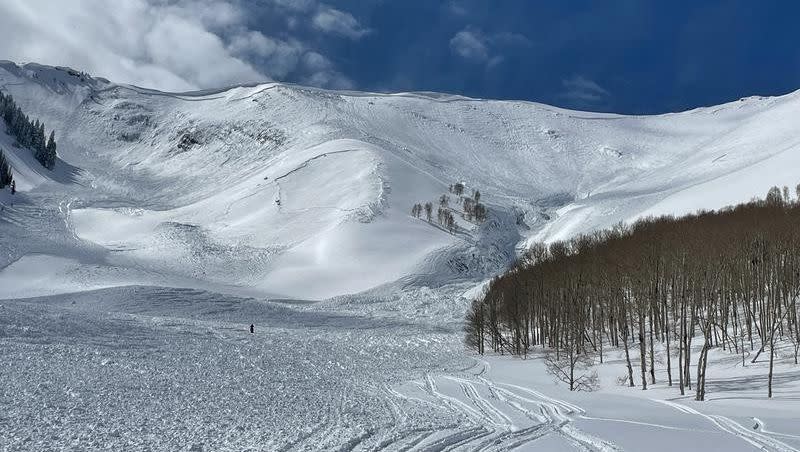Fatal avalanche in Utah County highlights Utah's dangerous conditions, experts say

Brett Warner and his brother traveled to their family's cabin in Ophir Canyon to ride snowmobiles with four friends on March 27.
It was a mostly clear day in the snowy mountains as they started their journey in the canyon, turning east into nearby Hall Canyon and then into Halls Basin near Flat Top Mountain on Utah County's western edge. Once at the top, they posed for photos and recorded the visit just like they do all the time.
Nothing seemed wrong at the time. Warner and his brother stayed by the top of the mountain as their friends traveled back, so they could spend more time soaking at the moment. They also spotted signs of avalanche danger from the top, noticing a recent avalanche to the south of them.
These were the moments before an avalanche came barreling down after the two brothers in Pole Canyon, killing Warner, 38, and nearly carrying his brother, compiled in a new report released by the Utah Avalanche Center on Tuesday. The agency writes that the avalanche was 4,500 feet wide and 3 feet deep, traveling 2,250 feet into the canyon.
It was Utah's second fatal avalanche this year, following one in Weber Canyon that killed a skier earlier in the month. The report was issued as avalanche danger remains extremely high across northern Utah, prompting closures, ongoing avalanche mitigation efforts and warnings.
The Pole Canyon avalanche
Warner's brother began his descent on the mountain around 6 p.m., slowly moving into the bowl from Flat Top Mountain, with Warner following. They were familiar with the area but something about the moment didn't seem right.
As they continued down into Pole Canyon, Warner's brother suddenly noticed "a massive powder cloud barreling downhill toward him" and "immediately cut to his left to escape the avalanche and was able to ride safely out of the path," the Utah Avalanche Center report states.
It's unclear where Warner was when the avalanche began other than he was behind his brother. He radioed to his brother, saying "not good, not good" and deployed an airbag backpack as the avalanche descended on the two, the report adds. The brother escaped the edge of the avalanche but Warner was carried by the slide.
His brother called 911 at 6:10 p.m. as the avalanche continued, requesting help because he knew Warner was trapped. He hung up on the call to try and find Warner, using a transceiver to search but the snowmobile was causing interference.
The report notes that Utah County Sheriff's Office search and rescue arrived about an hour later, finding Warner's brother and the group of friends trying to find the missing man. Crews found Warner's snowmobile after about another hour of searching and then found Warner's body, which was buried in 13 feet of snow. His airbag was ruptured, possibly by the "pressure of the avalanche debris," the report adds.
Utah Avalanche Center teams arrived at the canyon to review the avalanche. They determined that it was unintentionally triggered on a 38-degree slope at about 10,400 feet elevation in the canyon.
In a video uploaded along with the report, Utah Avalanche Center director Mark Staples explained that heavy snow from the past few weeks fell on top of a weaker layer of snow, making the canyon prone to avalanches at the time the brothers entered it.
"What jumps out to me is that it's very shallow," Staples said, standing at the site where the avalanche began. "This area has gotten a lot of snow. What that tells me is that this bowl has likely avalanched once or twice or who knows how many times. Bottom line, it's made a thin snowpack, and thin snow exposed to cold temperatures created these very obvious loose facets — that's what the avalanche failed on."
The agency released the report in hopes that it can "help others stay safe in the mountain by learning from it." The full report can be found here.
Ongoing avalanche danger
This week's storms, which have dropped over 5 feet of snow in some mountain areas, are causing similarly dangerous avalanche conditions across the Wasatch Mountains. Utah's statewide snowpack has gained about 5½ inches of water since March 19 — or nearly one-fifth of the entire record snowpack collection this season — which showcases exactly how heavy and water-packed the new snow is.
Avalanche warning continues today for Wasatch Range and Bear River Range. Expect avalanches even at low elevations in the foothills. They will break wider and run further than normal. Also, watch out for roof avalanches. pic.twitter.com/5mrakI3w4w
— UtahAvalancheCenter (@UACwasatch) April 5, 2023
The Logan, Ogden, Provo, Salt Lake and Uinta mountain areas remain in high avalanche danger Wednesday, according to the center. Individuals are advised to avoid backcountry slopes with elevations of 30 degrees or higher, as natural and human-triggered avalanches are likely.
"People should avoid being in avalanche terrain and stay well clear of avalanche runouts," avalanche forecasters wrote in an alert.
The agency adds that avalanches are possible in elevations as low as the region's foothills, in addition to roof avalanches where heavy amounts of snow on rooftops fall down next to a structure. The region remains in a winter storm warning through 6 p.m. Wednesday, but avalanche conditions may remain high or considerable for the next little while.
Entire canyons have been closed at times because of avalanche threats and avalanche mitigation work, too. Jim Steenburgh, a professor of atmospheric science at the University of Utah, told KSL-TV on Tuesday that this work is important because the roadways can easily be impacted by avalanches.
"There's nothing to stop these avalanches from hitting the highway. People will say that the slide paths are greased … everything's buried," he said. "There's no trees, no rocks to break these things up, and so they're just running right to the road."
Contributing: Jed Boal

